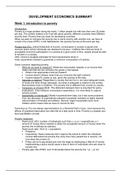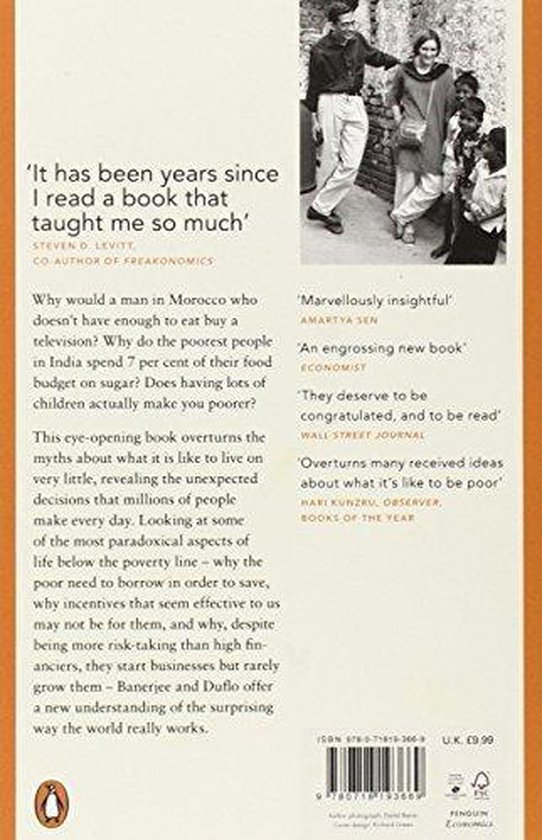DEVELOPMENT ECONOMICS SUMMARY
Week 1: introduction to poverty
Introduction
Poverty is a huge problem along the world. 1 billion people live with less than one US dollar
per day. The context matters a lot if we talk about poverty; different countries have different
poverty lines. Poverty lines lay lower for developing countries.
When we want to compare the poverty line in some country with another one, we have to
correct it for prices (PPP). In the Netherlands, the poverty line lies at 38 euros per day.
Poverty line (PL): critical thresholds of income, consumption or access to goods and
services below which individuals are declared to be poor. it defines the minimum level of
acceptable economic participation in a society at a given point of time. people should be able
to function in a society.
USA: minimum budgets estimates for food requirements times 3.
India: expenditure needed to guarantee a minimum consumption of calories.
Some concerns regarding poverty;
- What do we want to measure? Observed consumption baskets or an income that
make sure that we can consume the goods in this basket.
What is the appropriate minimum basket?
Income doesn’t always mean that you consume the right nutrients
Income based PL easier to use, given the scarcity of the data.
- Absolute or relative? Regardless to society that we live in, we need adequate levels
of foods and other things (absolute), but what is adequate is relative to the society
that someone lives in (relative). The poverty line is different from country to country.
- Temporary or chronic? Both. The distinction between them is important for policy
implications. If we measure consumption expenditure, it is more likely to capture
chronic poverty.
- Households or individuals? Mostly household-level data, but it has some problems.
First, the allocation of expenditures between household members is highly skewed
(discrimination of females and elderly). Second, larger households have more
children which means that we have to correct for this.
Summing up: PLs are always approximations to a threshold that is fuzzy, more because the
effects of sustained deprivation are often felt at a later point in time. Poverty is a deeper and
less quantifiable concept.
Poverty measures
- Head count (HC): number of individuals such that y < p (y = expenditures, p =
amount of money that is needed to attain the acceptable amount of money when the
poverty line is defined as calories).
Head count ratio: HC/n (n = population).
Problems:
Insensitivity: these measures don’t capture the extent to which the individual
income falls below the poverty line (only how many people live in poverty, not
how deep the poverty is).
Policy can be to get people just over the edge by distributing a little bit of money.
Implementing a policy would cause a bias in favor of individuals who are close to
poverty line.
- Poverty gap ratio (PGR): sum of all people below the poverty line * (p – y)/ nm
, Nm = income of the society. M = mean income. Dividing by this gives us an idea
how large the gap is relative to resources that potentially may be used to close
the gap.
Nominator = income needed to get all poor people to the poverty line
Problem:
Misleading in rich but unequal countries where PGR looks small (denominator will
be big).
Poor countries will have a higher ratio.
- The income gap ratio (IGP): sum of people in poverty * (p-y)/ p*HC
P*HC is the total income required to bring all poor people to the poverty line.
Reduces the denominator compared to PGR.
Acuteness of poverty is measures because its relative to total income needed to
make all poverty go away.
Not susceptible to policy bias.
No measure account for relative deprivation (inequality) among the poor (gap
between poor people in society).
Poverty is much more than only a lack of income. Also, lack of government utilities:
- Health
- Education
- Quality of life (searching for water instead of playing, working, etc…)
- Lack of capability to realize one’s full potential as human beings. Someone will not be
able to make use of their talents if they do not get enough nutrition.
Magnitude of the problem
- People are often overwhelmed by huge data about poverty and think that nothing can
be done to save the poor people. Therefore, we have to frame it in a way that it
seems “smaller” to people.
- Experiment where people could give money to one out of two flyers. One flyer made
the problem seem very big, while the other one made it very small. More people
choose to donate to the small problem, because the large problem is too
discouraging and they feel like they can’t do anything about it.
Solutions to poverty
1. What is the ultimate cause of poverty?
2. How much faith should we place in free markets?
3. Is democracy good for the poor?
4. Does foreign aid have a role to play?
there exist 2 views about how to solve poverty.
- Jeff Sach: countries are poor because of endemic problems (weather, geography)
unproductive no money to deal with the endemic problems. He proposes to break
the trap with foreign aid. Areas will become more productive with this money, and
therefore will get higher income and future investments.
- Bill Easterly: aid worsens corruption and blocks democracy and through history it has
proven to not be efficient. People will not find a solution on their own, local institutions
are undermined (people will be lazy and the money is not used to create institutions)
and it creates a self-perpetuating lobby of aid agencies and space for corruption.
Easterly thinks that poverty traps do not exist and that free markets (incentives are
right) should solve the problems.
What evidence do we have?
- Cross-country comparisons. Countries that grow faster than the rest received more
aid. Maybe things would have been much worse without aid. There is a problem of
, the lack of a counterfactual: we don’t know what would have happened to that
country when it didn’t get aid.
- We have concrete problems (healthcare, poverty traps, aspirations). We will dig
deeper into them the coming weeks.
- We also have concrete solutions to these problems. We will see this as well in the
next coming weeks.
An example
Malaria is a big problem in Africa. We observed that sleeping under a bed net decreased the
incidences by a lot. We have to make sure that we get people to sleep under a bed net.
There are externalities in this case and therefore the government has to provide the bed
nets. Easterly would say that the government should not subsidize or give them for free
since people will not value them, but Sachs says that the government should do this.
To be able to know what we have to do, we have to gather more information. Development
economists do this by running experiments. In experiments, there is always a treatment and
a control group, one of which will receive a treatment, and another one, who is in all aspects
the same as the treatment group, don’t get the treatment. However, it is extremely difficult to
have a comparison group that is exactly the same in all aspects as the treatment group. One
tiny difference can already influence the results and therefore, development economists use
Randomized Control Trials.
Week 2: empirical methods part 1
Causation
It is extremely important to detect causation, because this can give us important policy
implications. However, there is a correlation fallacy which says that we make logical
mistakes of believing that because two events occurred together, there is a cause-and-effect
relationship. For example:
People that speak English are wealthier.
Is it the case that speaking English makes someone wealthier or are the wealthy people
more able to afford education and therefore speak better English?
Without enough care it is easy to fall in absurd conclusions.
The problem of causal inference
We can find the causal impact when we have the counterfactual. In case of the effect of a
program on future earnings this would mean that we would have to know both the amount of
money that individuals who went to school would have earned in the absence of education
and in the presence of it.
Comparing individuals over time doesn’t give a reliable estimate because there might be
other, unobserved, factors that can affect the results (earnings can be affected by a lot of
things).
There also exists a self-selection bias in many cases. For example, because individuals
choose themselves to go to college or not, and this affects earnings as well.
The impact on grades using textbooks in school
Those who participate are compared to a similar group of individuals who were not exposed
to the program for reasons that were exogenous to whatever factor that can affect the
outcomes of the program.
Treatment group = people that receive textbooks
Comparison group = a school that did not participate the experiment and therefore did not
receive textbooks. In the absence of the treatment, they should have had the same outcome
as the treatment group. Exogenous means that it doesn’t affect our dependent variable other
than through the independent variable. Allocation to treatment must be random.
, In mathematics:
• 𝑌𝑇: average grades in school i if the school has Text books (Treatment)
• 𝑌𝐶: average grades in (the same) school i if the school has NO Text books (Comparison)
• 𝑌 : actual observed average grades of children in school i.
• 𝑌𝑇 − 𝑌𝐶: effect on average grades of having textbooks for school i.
problem: we cannot observe the same school with the treatment and without the
treatment simultaneously. Every school has two potential outcomes, but we can observe
only one.
We need another school that is similar in characteristics but did not receive textbooks.
D= E(𝑌𝑇 | 𝑆𝑐h𝑜𝑜𝑙 h𝑎𝑠 𝑇𝑒𝑥𝑡𝑏𝑜𝑜𝑘𝑠) – E(𝑌𝐶 | 𝑆𝑐h𝑜𝑜𝑙 h𝑎𝑠 𝑁𝑂 𝑇𝑒𝑥𝑡𝑏𝑜𝑜𝑘𝑠) =E(𝑌𝑇 |
T) −E (𝑌𝐶 | C).
What would be the counterfactual? What would have been the average grades of a school
with books if the school didn’t have books? E(Yc | T): average grades in the treatment
group given that the school would not been treated.
(+ counterfactual and – counterfactual).
Treatment effect = effect of the treatment on the treated
Selection bias = difference in potential untreated outcomes between the treatment and the
comparison schools. Treatment schools may have had different test scores on average even
if they had not been treated. Some school can be better already without the treatment (if
selection bias is 0, the two groups are exactly the same).
Selection bias arises when individuals are selected for treatment based on characteristics
that may affect their outcomes. This makes it difficult to disentangle the treatment effect,
because other factors can affect the outcomes.
We can solve the selection bias by making use of:
- Instrumental variable approach
- Randomized Control Trials.
IV estimation
Effect of police on crime.
If a city hires more policemen per capita, will its crime rate fall?
Data on policemen per capita and number of crimes per capita per city.
run OLS regression: 𝑌=𝛼+𝛽𝑋+𝜀
Y = crimes per year per capita
X = number of policemen per capita
What sign should beta have? The more policemen, the less crimes we would expect, so beta
should be negative.
When we look at the results, however, we observe a positive beta. Policy recommendation
would be to fire all the policemen…
But… there is a problem here. In order to have unbiased results, all Gauss-Markov
assumptions should be verified. The most important one is that the error term is uncorrelated
with the independent variable.
The assumption can be violated in three ways:
- Measurement error (ME)
Typically present.
Normally it cannot chane the sign of the coefficient but causes it to be 0.






